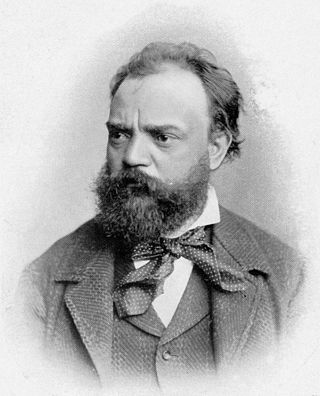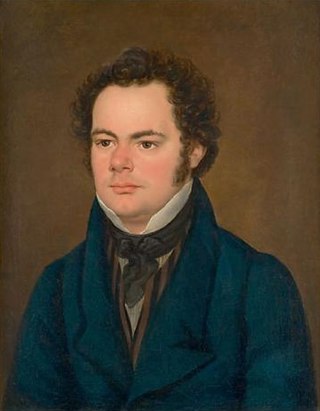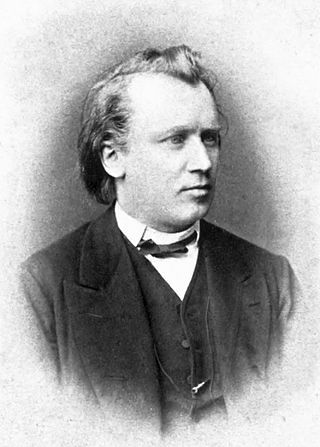
The String Quartet No. 14 in C♯ minor, Op. 131, was completed by Ludwig van Beethoven in 1826. It is the last-composed of a trio of string quartets, written in the order Opp. 132, 130, 131.

Ludwig van Beethoven's String Quartet No. 11 in F minor, Op. 95, from 1810, was his last before his late string quartets. It is commonly referred to as the "Serioso," stemming from his title "Quartett[o] Serioso" at the beginning and the tempo designation for the third movement.
The String Quartet No. 15 in G major, D. 887, was the last quartet written by Franz Schubert in June 1826. It was posthumously published in 1851, as Op. 161. The work focuses on lyrical ideas and explores far-reaching major and minor modes, which was uncommon to this degree in his compositions. Schubert reinforced this with a range of dynamic contrast and use of texture and pizzicato. The structural form of the movements in this quartet are somewhat ambiguous due to Schubert's focus on lyricism rather than traditional harmonic structure.
The Simple Symphony, Op. 4, is a work for string orchestra or string quartet by Benjamin Britten. It was written between December 1933 and February 1934 in Lowestoft, using material that the composer had written as a child, between 1923 and 1926. It received its first performance in 1934 at Stuart Hall in Norwich, with Britten conducting an amateur orchestra.

The Piano Trio No. 2 in E minor, Op. 67, is a piece for violin, cello and piano by the Russian composer Dmitri Shostakovich, started in late 1943 and completed in August the following year. It was premiered on 14 November 1944. The piece was dedicated to his close friend Ivan Sollertinsky, whose death in February 1944 affected Shostakovich profoundly.

The Symphony No. 3 in C major, Op. 52, is a three-movement work for orchestra written from 1904 to 1907 by the Finnish composer Jean Sibelius.
Dmitri Shostakovich's String Quartet No. 2 in A major, Op. 68, was completed in September 1944 in just nineteen days in Ivanovo, 300 kilometres north-east of Moscow. It was premiered by the Beethoven Quartet and is dedicated to the composer Vissarion Shebalin. When Shostakovich began writing his Second String Quartet he had already completed eight of his fifteen symphonies. He was also half-way through his life. Another thirteen quartets remained to be composed, however, and they would come in rapid succession.
Dmitri Shostakovich's String Quartet No. 3 in F major, Op. 73, was composed in 1946. He wrote most of it between May and August of 1946 while visiting his summer home in Kellomäki. The Quartet was premiered in Moscow by the Beethoven Quartet, to whom it is dedicated, in December 1946.
Dmitri Shostakovich's String Quartet No. 6 in G major, Op. 101, was composed in the summer of 1956. It was premiered by the Beethoven Quartet in October 1956. It carries no dedication. The Beethoven Quartet recorded this work on the Mezhdunarodnaya Kniga label.
Dmitri Shostakovich began work on his String Quartet No. 7 in F-sharp minor, Op. 108, in May 1959 and completed it in March 1960. He dedicated it to the memory of his first wife Nina Vassilyevna Varzar, who died in December 1954. This piece was composed in the year that would have marked her 50th birthday. This quartet was premiered in Leningrad Glinka Concert Hall by the Beethoven Quartet on May 15, 1960.
Dmitri Shostakovich's String Quartet No. 11 in F minor, Op. 122 was finished on January 30, 1966, in Moscow. It was premiered by the Beethoven Quartet and is the first in a series of four quartets to be dedicated to members of the Quartet. Vasily Shirinsky was the dedicatee of the Eleventh, the quartet's second violinist, who died on August 16 of the previous year.
Antonín Dvořák's Serenade for Strings in E major, Op. 22 (B. 52), is one of the composer's most popular orchestral works. It was composed in just two weeks in May 1875.

The Piano Trio No. 4 in E minor, Op. 90, B. 166, is a composition by Antonín Dvořák for piano, violin and cello. It is among the composer's best-known works.
The six String Quartets, Op. 76, by Joseph Haydn were composed in 1797 or 1798 and dedicated to the Hungarian count Joseph Georg von Erdődy (1754–1824). They form the last complete set of string quartets that Haydn composed. At the time of the commission, Haydn was employed at the court of Prince Nicolaus Esterházy II and was composing the oratorio The Creation as well as Princess Maria Hermenegild Esterházy's annual mass.
The Op. 33 String Quartets were written by Joseph Haydn in the summer and Autumn of 1781 for the Viennese publisher Artaria. This set of string quartets has several nicknames, the most common of which is the "Russian" quartets, because Haydn dedicated the quartets to the Grand Duke Paul of Russia and many of the quartets were premiered on Christmas Day, 1781, at the Viennese apartment of the Duke's wife, the Grand Duchess Maria Feodorovna. Some scholars theorize that the "Russian" quartets were the inspiration for Mozart's six string quartets dedicated to Haydn, but no direct evidence has been found.

The Fantasia in F minor by Franz Schubert, D.940, for piano four hands, is one of Schubert's most important works for more than one pianist and one of his most important piano works altogether. He composed it in 1828, the last year of his life. A dedication to his former pupil Caroline Esterházy can only be found in the posthumous first edition, not in Schubert's autograph.

The Piano Quartet No. 3 in C minor, Op. 60, completed by Johannes Brahms in 1875, is scored for piano, violin, viola and cello. It is sometimes called the Werther Quartet after Goethe's The Sorrows of Young Werther. The premiere took place in Vienna on November 18, 1875, to an anxious public. Richard Wagner and his wife Cosima were in attendance.

The Piano Quartet No. 1 in G minor, Op. 25, was composed by Johannes Brahms between 1856 and 1861. It was premiered in 1861 in Hamburg, with Clara Schumann at the piano. It was also played in Vienna on 16 November 1862, with Brahms himself at the piano supported by members of the Hellmesberger Quartet. Like most piano quartets, it is scored for piano, violin, viola, and cello.
String Quartet No. 1 in B-flat major "Maori Quartet", Stiles 1.2.3.3 SQ1 is the first of Alfred Hill's seventeen string quartets. Its composition began before 1892, it was completed after 1896 and premiered only on 18 May 1911 in Sydney.







